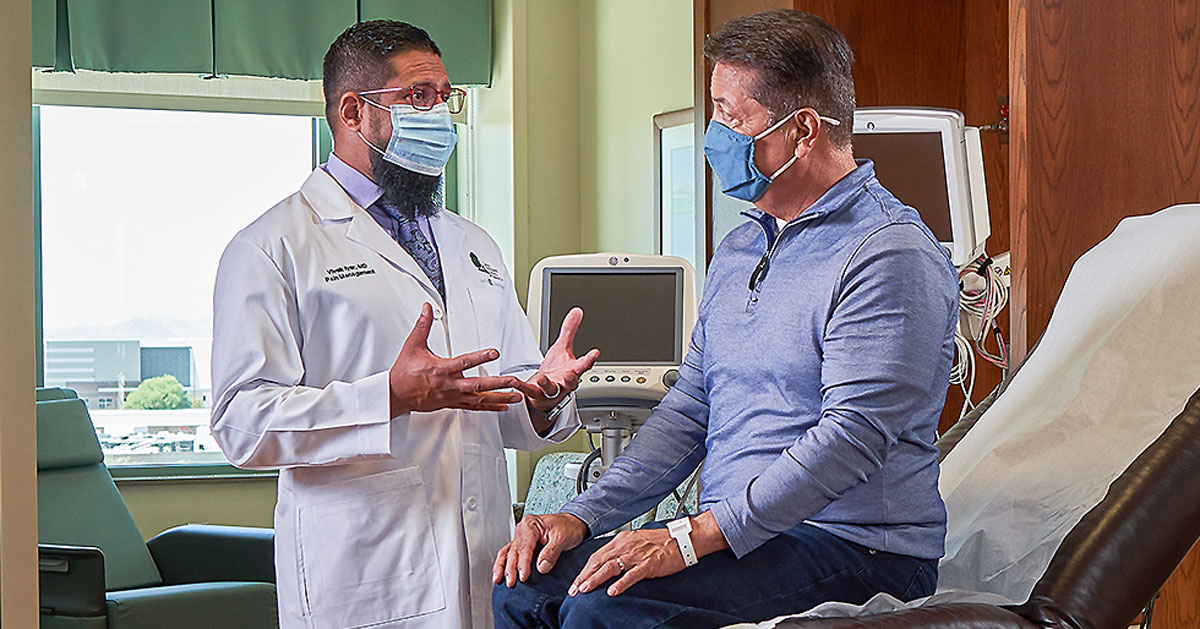
Cancer doesn’t always cause pain, but when it does, it typically means the cancer has advanced or spread. In fact, about 80 percent of people with advanced cancer experience pain, according to the National Cancer Institute.
And just as advanced cancers may be more difficult to treat, cancer-related pain may also be a challenge—mainly because its causes vary.
“We think of cancer as this mixed bag of pain sources,” says Nathan Neufeld, DO, Pain/Palliative Care Program Specialist at City of Hope® Cancer Center Atlanta. “Whether it’s eroding into something, weakening a bone and causing a fracture, or actually putting pressure on a nerve, cancer is this combination of nerve and tissue injury, which causes it to be quite complex but also pretty painful. That can also make cancer pain a difficult problem to treat.”
Cancer pain isn’t always just a symptom of the disease itself. Patients may experience pain as a side effect of treatments used to fight cancer. For example, radiation therapy may lead to inflamed or burned skin on top of the treated area. Chemotherapy may cause a type of nerve damage called peripheral neuropathy, which causes pain, numbness and tingling in the hands and feet.
Still, you shouldn’t accept cancer pain as an inescapable consequence of the disease. It’s often highly treatable—and not just with medicine.
In this article, we’ll explore:
- Stage 4 cancer pain management
- Talking to your care team about stage 4 cancer pain
- Managing pain at home for patients with advanced cancer
- End-stage cancer pain management
If you’ve been diagnosed with cancer and are interested in a second opinion on your diagnosis and treatment plan, call us or chat online with a member of our team.
Stage 4 cancer pain management
The methods used to reduce cancer-related pain are plentiful—and varied—ranging from strong pain medicines to interventional procedures to supportive care approaches like acupuncture.
According to Dr. Neufeld, there are two main categories for medical approaches to cancer pain management: medications and interventional procedures.
Stage 4 cancer pain medications
Opioids, like tramadol and oxycodone, work by attaching to pain receptors in the brain and other parts of the body to block the feeling of pain. Opioids come in long-acting and short-acting forms based on how quickly the medicine is released. Long-acting opioids take longer to work but provide relief for longer periods, while short-acting opioids work quickly but don’t provide relief for as long. Opioids are typically reserved for more severe pain and must be prescribed by a doctor.
Acetaminophen or nonsteroidal inflammatory drugs (NSAIDs) help reduce inflammation and are most often used to treat mild to moderate pain. NSAIDs include ibuprofen, naproxen and other over-the-counter options.
Other drugs, including antidepressants, anticonvulsants, local anesthetics and corticosteroids, also may be prescribed in addition to or instead of the options above.
Interventional procedures for advanced cancer
Nerve blocks are tissue injections used to deliver medications close to a targeted nerve or group of nerves. Nerve blocks help provide temporary pain relief and may also help doctors diagnose the source of nerve pain.
Radiation therapy is sometimes used to shrink tumors to relieve pain, even when the cancer has spread. This is often known as palliative radiation therapy.
Spinal cord stimulation uses an implanted device to deliver mild electrical signals to the spine.
“Most of the time with cancer, we talk about which kind of cancer it is,” Dr. Neufeld says. “For me, that doesn’t matter as much. It’s more of an anatomical question of determining where the pain is coming from so I can best treat it.”
For example, if a pancreatic cancer patient says the pain is coming from the upper abdomen, the doctor will typically recommend an injection that damages the celiac nerves—a bundle of abdominal nerves behind the pancreas. This interventional procedure, called a celiac plexus block, helps control pain in the abdomen because the damaged nerves can no longer send messages of pain to the brain.
Nerve blocks are often used as an alternative to medications because they help manage pain without side effects, like fatigue and dizziness, that are commonly associated with opioid-based drugs, nor do they have the addictive properties of opioids. NSAIDs may also cause side effects, such as stomach, heart, kidney and blood problems, especially in older patients.
Still, pain-relieving medications are typically effective when used as directed. And many times, doctors recommend both drugs and interventional procedures to treat pain from cancer. “They often work hand in hand,” Dr. Neufeld says.
Sometimes medications are also prescribed in combination. For example, aspirin, acetaminophen or ibuprofen are often added to oxycodone. And hydrocodone is sometimes used with acetaminophen or ibuprofen.
Just make sure to take pain medications as prescribed because they sometimes affect people differently and may interfere with other drugs. Both Tylenol® and Percocet® have acetaminophen, for instance, and acetaminophen should only be taken in limited amounts. That’s why it’s important to keep track of how much total acetaminophen you’re getting in a 24-hour period.
It’s also important to maintain the dose of the pain medication prescribed because changing it or stopping it altogether may cause additional side effects, such as gastrointestinal issues.
Talking to your care team about stage 4 cancer pain
When you experience cancer-related pain, it’s important to tell your care team.
Doctors typically try to locate the source of the pain, so they want to know an overview—where it hurts, when it started and whether anything seems to make it better or worse. They also want to know what the pain feels like: Is it sharp and burning? Achy and throbbing? “That can tell us whether it’s more of a nerve injury or a tissue injury and help guide treatment,” Dr. Neufeld says.
Patients can also keep what’s called a pain diary to track how much pain they’re experiencing and which tools may be helping to reduce it. Pain diaries may be particularly helpful when pain lasts a long time and patients and caregivers are unable to remember day-to-day details in between doctor visits.
Managing pain at home for patients with advanced cancer
But you don’t have to wait until your next doctor’s appointment to take action to manage cancer-related pain.
Behavioral approaches like mindfulness meditation and getting enough sleep may help. And, while it may seem counterintuitive, staying active is also a critical factor in pain management.
“If you sit too long or don’t get a lot of movement during the day, you can actually end up with more pain,” Dr. Neufeld says. “But don’t go overboard. That’s not the goal. It’s just maintaining some normalcy in your level of activity so you can stay active, keep your muscles from getting sore and focus your mind on things that promote health.” That could include practicing yoga or trying tai chi.
And remember that you can often take steps to manage cancer pain at home in addition to what your doctor prescribes—whether that’s pain medicine, an interventional procedure or a combination of the two.
End-stage cancer pain management
The default treatment for cancer-related pain, especially pain associated with advanced cancer, used to be narcotics, Dr. Neufeld says. “The thinking was, ‘We don’t want anyone to suffer, so we might as well start these drugs now.’ And while that’s true, that we don’t want anyone to suffer, there are so many more options today for how to relieve pain from cancer.”
For patients in hospice care, fewer limitations exist around pain management, so doctors typically use more aggressive methods to control it. Patients may also receive medications intravenously (or through IV) when they’re in hospice, which helps the drugs’ pain-relieving benefits take effect more quickly.
“That can be a real blessing to the patients who need it,” Dr. Neufeld says “I think one of the most compassionate things we can do as providers is to help people in a state of suffering. Whether that’s emotional, physical or spiritual suffering, we’re here to provide them with relief. But we can also help empower and embolden them through the removal of their suffering to do the things they want to do when they’re facing a terminal illness. I think that’s a neat opportunity we have that needs to be highlighted more in the management of cancer pain.”
If you’ve been diagnosed with cancer and are interested in a second opinion on your diagnosis and treatment plan, call us or chat online with a member of our team.


